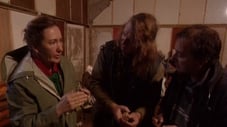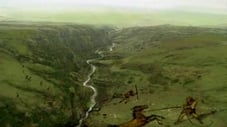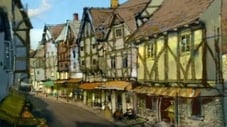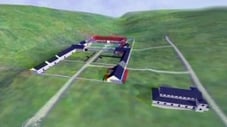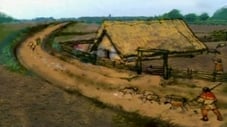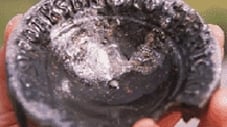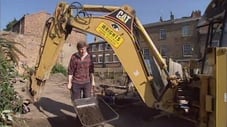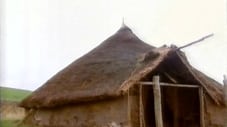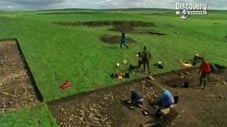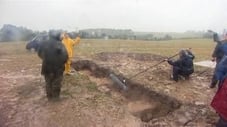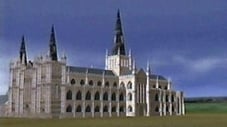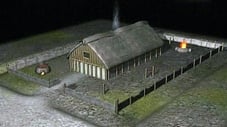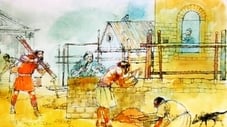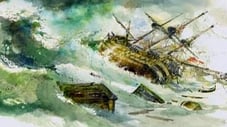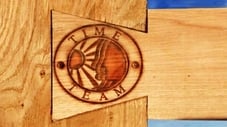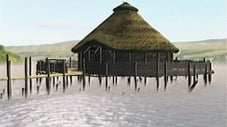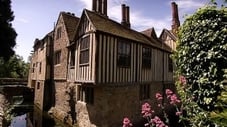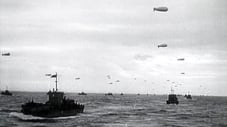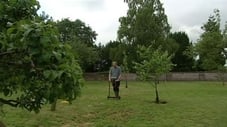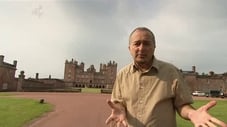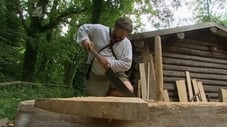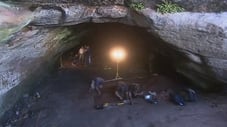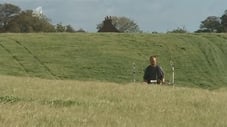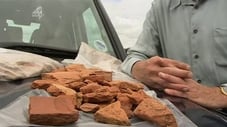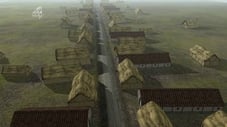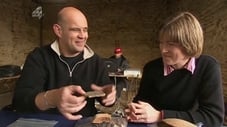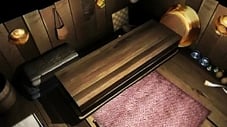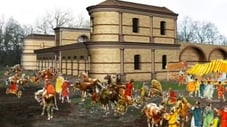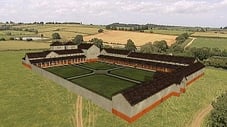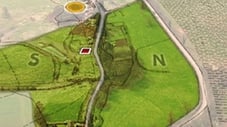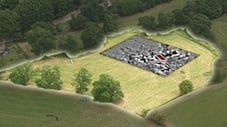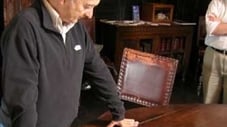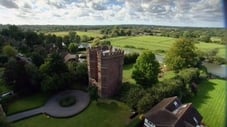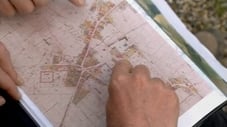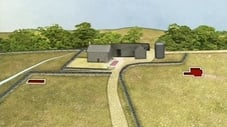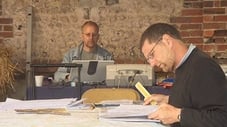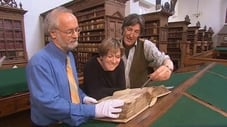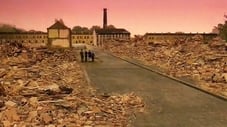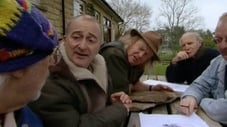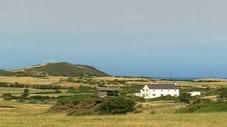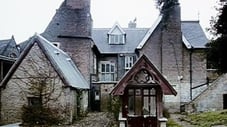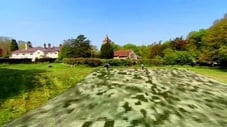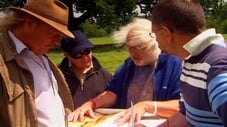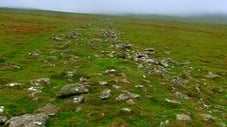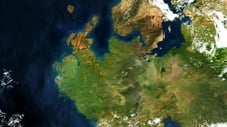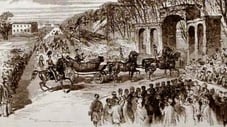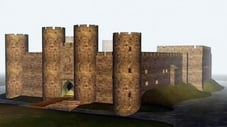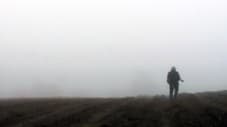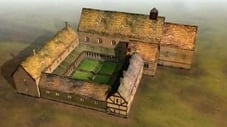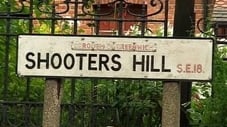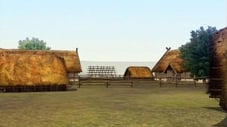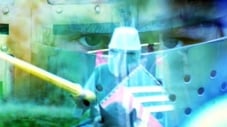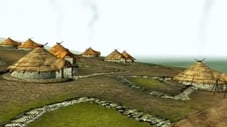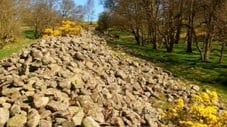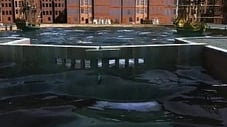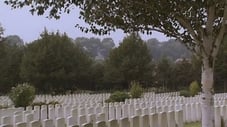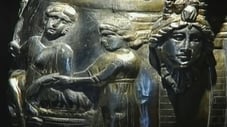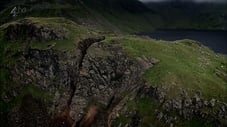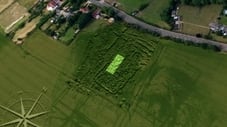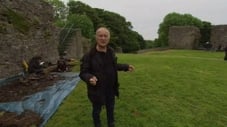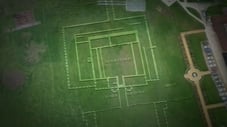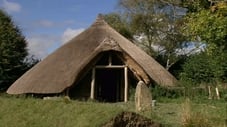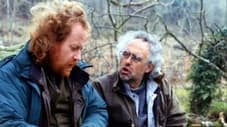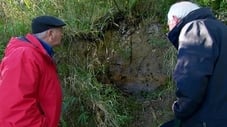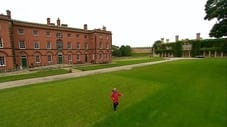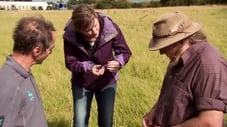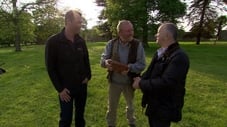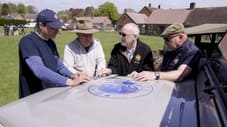
Time Team (1994)
← Back to main
Francis Pryor as Self - Bronze Age Specialist
Episodes 69
Christmas Special – Much Wenlock - Much Wenlock, Shropshire
As a curtain-raiser for the 1998 series of Time Team, which started in January 1998, Tony and the team gathered. The first Time Team special to air took a look back over the last five years. Over the years, viewers have flooded the series with queries as to what happened after Time Team finished their three-day investigations – were the sites further excavated, were finds available to see in museums and how did local people react to finding an important archaeological find on their doorstep?
Time Team returns to a few key sites for updated reports and the Team members also remember their favourite moments and finds.
Read MoreWedgwood's First Factory - Burslem, Stoke-On-Trent
The Team are in Burslem, Stoke-on-Trent, to investigate what remains of Josiah Wedgwood's first factory and to discover what pottery he was making there. They find evidence of several centuries of potting and bottle kilns, including a time capsule of the pottery of Enoch Wood & Sons. Experimental archaeology: a replica creamware vase.
Read MoreBack Garden Roman Finds - Papcastle, Cumbria
The team are in North West England, investigating Roman finds and a possible Roman building, unearthed in a family's back garden. The house is just 100 metres from a Roman fort, and south-west of the end of Hadrian's Wall. Geophysics are using state-of-the art Swedish radar equipment, to detect foundations beneath two metres of soil. A fragment of bronze mirror hints at a domestic settlement, a vicus, that would have sprung up next to the fort. But the diggers are finding plenty of archaeology, indicating much larger and more organised Roman building, possibly a city. Through the expertise of potter Gilbert Burroughes, the team are going to try to make a Samian ware bowl during the three days. The team are joined by Roman specialist Lindsay Allason-Jones.
Read MoreDominican Friary Church and Norman Cathedral - Thetford, Norfolk
Time Team have been invited by pupils of Thetford Grammar School in Norfolk, to investigate the remains of a Dominican friary church and a 1,000-year-old Norman cathedral, in their playground. There is much interest from the pupils when the team excavate human bones. Ecclesiastical historian Janet Burton describes the origins of the Dominican Order. Stonemason Simon Williams gives a practical demonstration of medieval wall-building using knapped flint and lime mortar. Stained glass expert David King confirms medieval dates for fragments from the friary. The junior school makes a timeline frieze, complete with felt bishops and monks. It all ends in an open evening for parents.
Read MoreCooper's Hole - Cheddar Gorge, Somerset
Investigation, at the invitation of the cave's owner, the Marquess of Bath, to see if there is evidence of Palaeolithic human activity in the cave. This may be among the oldest homes in England. The ultimate aim is to get the site scheduled and thus protected from unofficial damage. However it soon becomes clear there is a lot of preparatory work involved. They are joined by palaeontologist Andy Currant, and cave archaeologists Larry Barham and Kate Robson Brown. Caver Malcolm Cotter directs them to a cache of bones; but the tunnel is blocked by sediment from flooding.
Read MoreMedieval Plympton - Plympton, Devon
In the 12th century many towns were designed and laid out on regular lines. The people of Plympton believe there is enough evidence to plot the layout of the medieval town which surrounds the ruins of their castle, and which was formerly owned by the immensely powerful and wealthy de Redvers family. As usual, Time Team have three days to find it. Back gardens and interiors will provide the clues, rather than frontages which have probably been altered many times in the last 800 years. So they will need plenty of help from local householders. They are joined by Plymouth city archaeologist Keith Ray and dendrochronologist Robert Howard.
Read MoreTudor Dockyard - Smallhythe, Kent
Looking for evidence of a 15th century dock, the team are in Small Hythe. The dock was once next to the mile-wide River Rother but its location is now an overgrown field, ten miles from the sea. And early excavations reveal nothing more recent than wood from a prehistoric forest. Medieval ship expert Ian Friel explains that the dockyard used to have high naval significance, and was visited by Henry V. Woodworker Damian Goodburn uses authentic tools to build a ship's clinker hull. Victor draws the biggest ship ever built here, the Jesus. Using geophysics, John Gater and Sue Ovenden pinpoint the course of the old river. And very soon the finds start to accumulate, revealing the true scale of activity here.
Read MoreGolf Course Roman Bathhouse - Beauport Park, Sussex
Historian Guy de la Bedoyere asks the team to investigate the isolated ruins of a bath-house, discovered by Gerald Brodribb in the midst of dense Sussex woodland. Gerald has made a scale model of the building, and Guy explains the connection to the Roman navy. After a demonstration of dowsing from Gerald, the team's first task is to clear the land before digging. With ancient technology expert Jake Keen and blacksmith Reg Miles, Phil attempts to smelt iron using a traditional furnace. The team are also joined by archaeometallurgist Gerry McDonnell.
Read MoreBombers In Reedham Marshes - Reedham, Norfolk
Time Team team up with air crash investigators to discover what happened to two B-17 bombers which crashed with loss of all lives on board on 21 February 1944 into marshes near Reedham, Norfolk. The airplanes were returning from a bombing raid on a German target as part of the Big Week offensive. Parts of one airplane are recovered, and the Team speak to surviving crew members of a third plane that was in the formation. Experimental archaeology: A piece of nose art painted as a memorial to the bomber crews, painted by a former Red Cross volunteer who had painted some during WWII.
Read MoreBack To Turkdean - Turkdean, Gloucestershire
Time Team revisit a live dig from 1997, where they found a large Roman complex in a Gloucestershire field. But at the same time, geophysics recorded evidence of more buildings. And so the team have returned to investigate a greatly expanded area. Almost immediately Phil uncovers some impressive looking archaeology. They decide to build a Roman altar with a special inscription. They are rejoined by Roman specialists David Neal and Lindsay Allason-Jones.
Read MoreField Cropmarks - Kemerton, Worcestershire
An aerial survey of a Worcestershire field has revealed cropmarks leading to substantial Bronze Age finds. But Iron Age remains also exist. Time Team tries to sort it out. Local schoolchildren help with a bit of fieldwalking; and Mick shows how cropmarks and posthole marks become visible in fields. Francis Pryor explains the difference between Bronze Age and Iron Age and describes life in a roundhouse. Also joining the team are archaeologist Malcolm Atkin and environmentalist Liz Pearson; while wood specialist Guy Apter gets the kids to help make a Bronze Age ard (plough).
Read MoreRuined Norman Church - Bawsey, Norfolk
This live dig centres on a ruined Norman church on a hill in Norfolk. This National Trust site promises to be the richest source of finds that Time Team have yet seen, with previous evidence of human occupation from most periods in antiquity. This requires several trenches, including the longest one that Time Team have ever dug. They start with some fieldwalking and metal detectoring, before digging in earnest. Among many finds are a bronze age arrow head, a medieval tiled floor, coins and several well-preserved skeletons. One skull shows clear evidence of having been brutally slaughtered by a swordsman on horseback. The team are joined by Helen Geake, Neil Holbrook, Andrew Rogerson, pottery expert Paul Blinkhorn, osteoarchaeologist Margaret Cox, and historian John Blair. Celebrities Sandi Toksvig and Hugh Fearnley-Whittingstall also drop in. Hugh and Victor help Saxon re-enactor Russell Scott to recreate a bronze artefact from scratch.
Read MoreMontravers Estate (Part 1) - Nevis, West Indies
Invited by historian David Small, the team are on the tiny Caribbean island of Nevis, for a six-day dig to uncover the history of sugar production and slavery here. They are investigating a particular plantation, Montravers Estate, now overgrown, originally owned by wealthy 18th century Bristolean John Prater Pinney. Robin visits Bristol University, researching the extensive documentation. Back on Nevis, pottery expert David Barker is shown pottery sherds, most of which he dates to the 1840s. Phil crosses to neighbouring St. Kitts, to help make sugar from sugar cane. Sugar would have been extracted in a mill operated by teams of oxen. Molasses, the byproduct of sugar processing, was fermented to make rum. In the jungle Stewart searches for a slave village. They are also joined by local historian David Rollinson.
Read MoreMontravers Estate (Part 2) - Nevis, West Indies
Invited by historian David Small, the team are on the tiny Caribbean island of Nevis, for a six-day dig to uncover the history of sugar production and slavery here. They are investigating a particular plantation, Montravers Estate, now overgrown, originally owned by wealthy 18th century Bristolean John Prater Pinney. Robin visits Bristol University, researching the extensive documentation. Back on Nevis, pottery expert David Barker is shown pottery sherds, most of which he dates to the 1840s. Phil crosses to neighbouring St. Kitts, to help make sugar from sugar cane. Sugar would have been extracted in a mill operated by teams of oxen. Molasses, the byproduct of sugar processing, was fermented to make rum. In the jungle Stewart searches for a slave village. They are also joined by local historian David Rollinson.
Read MoreChristmas Special – Barley Hall - Barley Hall, York
This pre-Christmas special offers a taster of what is coming up in the next series – and provides an update on previous Time Team digs. Presented by Tony Robinson from York's Barley Hall, where a Medieval Christmas celebration is in full swing, the show tells what has happened at many of the digs featured in the last series.
Read MoreThe Mystery of Seahenge - Holme-Next-The-Sea, Norfolk
Last year, on this bleak and beautiful stretch of Norfolk coastline, a local man made an extraordinary discovery. Walking the beach at low tide he found a bronze axe head. Nearby, was a mysterious circle of eroded timber posts half buried in the sand, and in the middle of the circle was a huge upturned tree stump.
It’s utterly intriguing nothing quite like it’s ever been found before and everyone wants to know who built it, what it was for and what it originally looked like.
Read MoreYork
The dig's archaeological highs and lows are crammed into just 60 minutes in York where the finds range from a Roman skeleton complete with hobnailed boots, a Viking's discarded leather shoe, and the pillars of a monastic hospital. But what does all the evidence show? Who were these people and how did they live?
Read MoreThe Real King Arthur - Tintagel Castle, Cornwall
This king was called Arthur, and his stories known to us all. But actually he’s shrouded in mystery, some people say that he was a chivalrous medieval king. Others, a gritty Dark Age warrior, others again, that he never existed at all. Time Team are setting out on a quest of our own to see if we can find out who he really was. It’s a journey back in time through centuries of myth and legend, on the way we’ll visit sacred lakes, pull our own sword from the stone and uncover the very first archaeological host.
Read MoreThe Time Team History Of Britain
Time Team takes a trip from the Palaeolithic to the present and plots the nation's past through the finds and revelations made across the last seven series. The Team pays a visit to classic UK archaeological sites, such as Grimes Graves and Bede's World, and examines key digs from programmes past to look at how archaeologists have interpreted the nation's history.
Read MoreThe Mystery of Mine Howe - Tankerness, Orkney
I’m in a remote farm in the Orkneys on a little hillock called Mine Howe. For years there have been stories around here of tunnels under the roads and mysterious underground rooms, which have never been satisfactorily explained until about six months ago when an extraordinary discovery was made. Acting on stories of a lost secret chamber first found in 1946, a local farmer and his friends set out to rediscover it. What they found was extraordinary. A set of stairs made of stone, disappearing into the earth and leading to a dark and secret chamber.
A set of stairs leading into a hillock’s unique. And now the whole archaeological world is agog, everyone wants to know who built it and when and what it was put there for.
Read MoreBehind The Scenes At Time Team
This special programme looked behind the scenes at some of the things that you don't usually see in the normal Time Team programmes.
Read MoreThe Bone Caves - Alveston, Gloucestershire
The Battle of Bosworth was the decisive battle of the Wars of the Roses. It was the beginning of the end of three decades of treason, rebellion and dynastic warfare. Against huge odds, Henry Tudor won the day to take the English Crown. It was a turning point in English history, the end of the Middle Ages and the savage beginnings of the country we recognise today.
Read MoreCoventry’s Lost Cathedral - Coventry, West Midlands
Welcome to what used to be the quiet backgarden of Coventry Cathedral's offices. Quiet that is, until Time Team kick-started an excavation into St Mary's, Coventry's first Cathedral which was ruthlessly destroyed by Henry the Eighth during the reformation. Over three days in 1999 we uncovered the remains of a building which would once have rivalled any Cathedral in England and yet work on this fantastic site had barely begun.
Read MoreThe Island of the Eels - Ely, Cambridgeshire
Time Team has been following an excavation in Ely, Cambridgeshire, for a feature-length documentary screened on 17 May. It has uncovered a remarkable picture of Ely in past centuries: channels where boats used to moor to load and unload goods; a medieval kiln with huge quantities of high-quality pottery finds; and a number of buildings fronting the road at Broad Street.
Read MoreDinosaur Hunters - Dinosaur Belt, Montana, USA
If you think archaeologists with their strange haircuts and their bizarre dress sense and their obsession with all the rubbish from ancient civilizations are a funny lot, you ain’t seen nothing yet. Phil and I are in Montana, in the wild west of the USA. And every summer, what seem like half the eccentrics in the universe turn up here to dig for even larger remains from times even longer ago. We’re here to meet the dinosaur hunters, we wanna find out what they do, and how they do it and hopefully even have a go ourselves.
Read MoreThe Big Dig in Canterbury - Canterbury, Kent
I’m right at the top of Canterbury cathedral and a few hundred feet below me, the most ambitious urban archaeological project the country’s ever known, has just begun. One eighth of the entire ancient city is gonna be excavated to make way for a huge new shopping centre. The Big Dig as its known locally is right down there in the centre of town. So it should be jam packed full of exciting archaeology from the present day, back to the Romans and maybe even beyond.
The Archaeologists are up against the clock though. The developers want them off site as quickly as possible. The Time Team are gonna be following the progress of the big dig both onsite and behind the scenes and were gonna be helping the local team to reconstruct the 2000 year story of this historic piece of Canterbury real estate.
Oh… And we’ve got just nine months to do it.
Read MoreLondinium, The Edge of an Empire - London
2000 years ago, London didn’t exist. It was created by the Romans in the first century AD. They settled just over there in what we now call the city. It started as a simple bridge over a river, but within a hundred years had become a bustling city with a population of 30,000. But it was a long way from Rome, and Londinium has always been considered a bit of a frontier town, an unsoffisticated outpost perched precariously on the very edge of the Roman empire, until now. Over the last nine months, archaeologists from the Museum of London have been working on a site right in the heart of the city, and what they’ve discovered, suggests that Londinium was in fact one of the most soffisticated and advanced cities in the whole Roman empire.
Read MoreThe Wreck of the Colossus - St Mary’s, Isles of Scilly
HMS Victory, probably the most famous English warship of all time. Everyone knows the story of how the Victory, under the command of Admiral Lord Nelson routed the French at the battle of Trafalgar and how Nelson died a national hero. Quite rightly, this is a perfectly preserved piece of our maritime heritage, but what happened to the other ships under Nelson’s command, where are they? Well, the simple answer is, they’re all long gone. Either destroyed in battle, lost at sea, broken up or just rotted away. Well, maybe not quite all. This is a story about the underwater excavation of one of Nelson’s lost ships. It involves Nelson’s mistress, Emma Hamilton; her husband, amateur archaeologist, Sir William Hamilton; a priceless collection of antiquities; a shipwreck and the discovery and raising of one of the most important pieces of maritime art ever found in British waters.
Read MoreTen Years of Time Team
Ten years ago university lecturer, Mick Aston was teaching archaeology to classes of just 30 students. Now, thanks to television, Mick, Tony and the team reach an audience of over 3 million.
Time Team, Channel 4's award winning archaeology show is ten years old.
Read MoreHadrian's Well
A team of expert engineers, archaeologists and craftsmen are about to join forces in an epic archaeological experiment, to build a full size working replica of a Roman water lifting machine.
At almost 4 meters in height, capable of raising 7000 litres of water per hour, this was ancient cutting edge technology.
But no-one really knows how it worked or what it really looked like. What we do know is that the machine has to be installed and working in the Museum of London in three months time.
Read MoreBig Dig, The Hole Story - Canterbury, Kent
Digs at Great Easton, Leicestershire; Wolverhampton; Barnet; Oakamoor; Preston; Cheltenham; Upminster and Groundwell Ridge in Swindon.
Read MoreSheffield Steel City - Sheffield, South Yorkshire
The team followed ARCUS, the Archaeological Research and Consultancy at the University of Sheffield, on some of its excavations into Sheffield's industrial past. Early death, deadly machinery and the worst man-made disaster in British history were revealed as Time Team documented the work of the archaeologists who have spent more than six years digging through the remains of a city that was once the biggest producer of steel in the world.
Read MoreThe Crannog in the Loch - Loch Tay, Perthshire, Scotland
Loch Tay, and the kind of view that draws people to Scotland. But the landscape isn’t the main attraction for archaeologists Nick Dixon and Barrie Andrian, who are much more interested in what they can see in the shallow waters around the edge of this loch. In this time team special documentary, you’ll be submerged into the world of underwater archaeology, and visit an Iron Age house that hasn’t been seen since prehistoric times. Are you ready? Stand by to dive into the Iron Age.
Read MoreThe Ten Million Pound House - Ightham Mote, Kent
Hidden away in Kent is an architectural gem.
A house that has some how survived with a little bit of every fashion imposed on it over seven centuries. This is Ightham Mote near Sevenoaks, bits of it date back to 1320 and officially it’s the most complete moated medieval manor house in the UK. At least it was until the National Trust started it’s most ambitious and expensive restoration project to date.
Since 1989 this building has been literally taken apart brick by brick and beam by beam revealing the hidden history of the house for the first time.
In this special Time Team documentary you will discover along with me that this is a totally different kind of archaeology. You’ll learn something about the twenty generations who lived here and see some of the things they deliberately hid away.
Read MoreD-Day - Normandy
60 years ago on D-Day, the allies invaded Nazi occupied France. The invasion force made up of a 150,000 US, British and Canadian troops, was the largest in the history of western civilization. The Americans were to land on Omaha and Utah beaches, Canadians on Juno and the British on Sword and Gold. Almost half of the total troops were British and among them were the 400 infantrymen of the first Dorset regiment. They landed here on Gold beach on the 6th of June 1944, and this is the story of their day.
Read MoreThe Manor That's Back to Front - Chenies Manor House, Buckinghamshire
Tony Robinson and the team visit Chenies Manor which is believed to have been upgraded in time for Henry VIII's visit around 1530. However, while a late 16th-century inventory suggests that an additional range of rooms fit for a king once existed, traces of them have vanished since the house fell into disrepair. Can the experts uncover the layout of the building as it appeared in Tudor times?
Read MoreThe Monastery and the Mansion - Nether Poppleton, Yorkshire
The villagers of Nether Poppleton, near York, join Tony Robinson and the team for some extensive digging as they try to determine the exact age of their village. The current layout follows a typical medieval pattern but a reference to the village in the Domesday Book has the experts thinking that it could date back to Saxon times at least.
Read MoreThe Bombers in the Marsh - Warton near Preston, Lancashire
On 29 November 1944, two US Douglas A-26 Invader bombers crashed in Warton Marsh. Both planes, along with a number of others, had left Warton Airbase in formation, en route to join forces in the preparations for the Battle of the Bulge. Only one minute off the runway and 1,000 feet into the air, the aircraft collided and came to rest in the marsh. All the crew died. Their bodies were recovered from the planes, but an investigation into the causes of the crash was inconclusive.
For this programme, Time Team enlisted a veteran air crash investigator, along with the RAF's 'crash and smash' team and other experts to try to find out what caused the crash. Each of the planes, including the engines, was believed to be relatively intact and, it was hoped, would provide the necessary information to determine why these two planes collided.
Read MoreFighting On The Frontier - Drumlanrig, Dumfries and Galloway
Twenty years ago, during a particularly dry summer, parch marks revealed what seemed to be a huge Roman fort a few hundred metres from the Duke of Buccleuch's extraordinarily grand house, Drumlanrig Castle, in Dumfries. The discovery lay untouched until Time Team took on the challenge to investigate it further.
The Team sought to answer a number of questions. Was it actually a Roman fort? If so, it was one of the most northerly ever found and therefore of special importance to Scotland's history. So when were the Romans there? No finds made previously had given any hint of the date of the structure.
Time Team also wanted to identify the roads leading in and out of the fort. Was there any kind of civilian settlement or other features nearby? And could the Team work out how the Romans made their famous draco, the military standard that made a sound said to have struck fear into the hearts of their enemies?
Read MoreA Neolithic Cathedral? - Northborough, Peterborough
The Time Team is invited to a huge circular crop mark near Peterborough, referred to as a causewayed enclosure by archaeologists. Huge ditches mark the area, which date the site at around 6,000 years old. Some believe the ditches to be evidence of farming, others that they are of religious origin. Francis Pryor and Ben Robinson join the team to get to the bottom of the mystery in just three days.
Read MoreIn Search of Henry V's Flagship, Grace Dieu - Bursledon, Hampshire
The team have three days to explore the skeleton of a medieval warship found on the bed of the River Hamble near Southampton. They must prove whether it is the Grace Dieu, Henry V's naval flagship, and also find out how big it was and just why it came to grief. The team are joined by John Adams (marine archeologist) and Susan Rose (historian). Damian Goodburn (ancient ship expert) attempts to reproduce a small section of the massive ship's clinker built hull.
Read MoreGoing Upmarket With The Romans - Standish, Gloucestershire
For years, a field near Standish in Gloucestershire has yielded Roman brooches, mosaic tiles and coins. The finds point to a sizeable villa somewhere nearby - but so far none has been found. Tony Robinson and the team have just three days to solve the mystery. There are plenty of signs that people lived in the area from the Iron Age through to the Roman period, but no sign of the villa.
But clue by clue the archaeologists piece together the puzzle to reveal an extraordinary picture of several generations of one family living through huge social change and gradually improving their lifestyle as Romanised Britain became more and more prosperous.
Read MorePicts And Hermits: Cave Dwellers Of Fife - Wemyss, Fife
Wemyss Caves, on the shore of the Firth of Forth, have been a famous landmark for centuries. Legend has it that they were occupied by the mysterious Pictish people who scared the Romans into building Hadrian's Wall; that subsequently they were home to medieval Christian hermits and later to Jacobean nobles. Now the caves are under serious threat from erosion; the sea is already lapping at the cliff just below the cave line.
But Wemyss Caves have never been properly investigated. How did the enigmatic Pictish carvings on the cave wall get there? And did Picts really live in the caves or were they just passing by? Is there any evidence of hermits or other types of medieval occupation? In an intensive three days, Time Team come up with some remarkable answers, beginning the task of re-writing the history of this atmospheric site.
Read MoreLost Centuries Of St Osyth - St Osyth, Essex
7th century Vikings sailed up an Essex creek. Legends tells hold they captured a nun who was offered her modesty or her mortality, chose death. The nun carried her severed head up the hill to her church and collapsed. A spring bubbled up. The nun was St Osyth, the wife of the King of Essex. The site of her death became a shrine and a settlement grew up. In the 12th century Richard de Belmais, Bishop of London, founded an Augustinian Priory in the village. It prospered until the Dissolution in 1539 and was one of the wealthiest monasteries in Europe. A few years ago a local boatbuilder noticed some decayed timbers in the mud of St Osyth Creek. The tides gradually revealed more of these timbers, which are on a significant bend in the channel. These timbers could be the remains of a medieval wharf which served the town in its early days, but they could also be the key to a much bigger mystery. The present town seems to date to the 15th century but the famous Priory is much older.
Read MoreNorman Neighbours - Skipsea, East Yorkshire
For years Time Team fan Frances Davies has been collecting finds from the field outside her back door in Skipsea in East Yorkshire. She has uncovered Neolithic, Roman and Saxon items, but her best finds are medieval pots dating from the Norman Conquest. It's clear that there was some habitation in the area 1,000 years ago, but a geophysics plot of the site reveals incredible results, far beyond the team's expectations. Could Frances have had a whole Norman village in her field, a village lost to the records? And could there be a clue in nearby Skipsea Castle, the seat of power of the Norman overlord of the whole area? The Team have three days to find out.
Read MoreThe Puzzle Of Picket's Farm - South Perrott, Dorset
Time Team heads to South Perrott in Dorset, inspired by the intriguing discovery of Roman brooches and coins in a hilltop field. The Team are pretty sure they're going to uncover a Roman Temple, but the search gets off to a bad start when all the pottery turns out to be medieval and there's no sign of any buildings.
Something has clearly been going on in this field, but it's not what they thought. The trenches gradually reveal their contents, painting a very different picture from a very different period. Have the Team stumbled across a Stone Age burial site that had, extraordinarily, been honoured for thousands of years right into Roman times? Prehistory specialist Miles Russell explains some aspects of Bronze Age features.
Read MoreTower Blocks And Togas - South Shields, Tyneside
In South Shields, the Roman Fort at the end of Hadrian's Wall is a local landmark and the team embark on a quest to locate the site of a huge Roman military cemetery thought to be in the area. They search all nearby open spaces but come to the conclusion that the likeliest site of the cemetery is beneath a 1960s housing estate. A few tombstones and burials have been found in the past hundred years, but there must be a huge Roman military cemetery somewhere. Time Team use every spare piece of open space, have a look under the occasional pavement and enlist as much local help, young and old, as possible in their hunt for the site. It's three days of head-scratching mayhem before the answer emerges.
Read MoreAnimal Farm - Hanslope, Milton Keynes
An unusual horse bit, some posh finds and carved stonework lead Time Team on a search for a Norman hunting lodge in Northamptonshire. But it isn't long before the lodge's massive stone walls begin to look a little less impressive, and, under the forensic trowels of the diggers, the lodge shrinks in every direction. But royal forests were fiercely protected by the Norman nobility; why are there buildings here at all? Does the Domesday Book hold a clue? It seems as if this area was home to an extraordinary number of pigs... Have the Team come across one of the very first factory farms?
Read MoreThe King of Bling - Prittlewell, Essex
It might not seem it, but this damp piece of unprepresessing scrub is at the heart of one of the most important discoveries in British archaeological history. Just below the surface here, diggers found the tomb of an Anglo-Saxon King, crammed with ornate finds from across Europe, and that was just the start, of a fascinating detective story. Who was this mysterious King? Archaeologists have spent the last twelve months unpicking this site and pouring over the finds trying to find hidden clues which could reveal the identity of the person who was buried here, and Time Team has been with them all the way.
Read MoreBritain’s Lost Roman Circus - Colchester, Essex
Tony Robinson, Phil Harding and Guy de la Bedoyere tell the story of the discovery of the only Roman circus ever found in Britain, just outside Colchester's Roman walls. They investigate the history of the circus and explore the rough, tough world of chariot racing.
Read MoreLife on the Edge 1000 Years BC - Washingborough, Lincoln
Three thousand years ago the River Witham, just outside Lincoln, was a busy place. In the cold wet Autumn of 2004, archaeologists were given just six weeks to rescue the fragile evidence of a major Bronze Age settlement, before it would be buried under tons of clay when the river’s flood defences were strengthened. With frequent visits from Tome Team regulars, Mick Aston and Phil Harding, this Time Team Special follows the progress of this extraordinary dig, and witnesses the spectacle of literally thousands of prehistoric finds being unearthed and analysed.
Read MoreDurrington, Somerset - Durrington Walls
Stonehenge may be Britain's most famous henge: a massive monument and ancient construction that is shrouded in mystery. But a mile away is an even bigger henge: Durrington Walls. In a major excavation this summer, archaeologists linked the two monuments and revealed an extraordinary and sophisticated picture of Stone Age life.
The henge at Durrington was a mile round, a gleaming white bank of chalk sitting in the Wessex landscape. Leading down to the nearby river, a road was uncovered: the first Neolithic road to be discovered in Europe. Down that road would have tramped thousands of people, carrying the cremated remains of their recent dead.
Can the team prove it was the start of a journey for the ancestors' spirits down the River Avon to the permanent memorial of Stonehenge? Even more remarkable, inside the henge was a huge wooden monument with 160 trees arranged in perfect circles. The piles of finds indicate the aftermath of great feasts, so to understand the monument better, Time Team takes on the mammoth task of building a full-size replica. It is impressive and the theories flow thick and fast. Could the midwinter alignment mean this may be the first recorded "Christmas", 2,500 years before Christ was born? Prod: Sian Price; Exec Prod: Philip Clarke.
Read MoreDinnington, Somerset - Big Roman Villa
Tony Robinson presents the story of the excavation of a big Roman villa in Somerset, originally discovered by Time Team in 2002 and revisited in 2005. The programme demonstrates how the villa grew from a small farm building to a fine stone building, and how that was expanded again and turned round to face the busy new Fosse Way.
Read MoreThe Bodies in the Shed - Glendon, Northamptonshire
The Team is visiting Glendon Hall to unravel the mystery of the human skeletons found under an outbuilding. The team are joined by Richard Morriss (historic building consultant) and Glenn Foard (landscape archaeologist).
Read MoreVillas out of Molehills - Withington, Gloucestershire
When a colony of moles brings up pieces of mosaic floor in a Cotswold field, Tony Robinson and the team investigate whether the findings could be linked to a nearby Roman villa discovered almost 200 years ago. A local spring might give a clue to the true purpose of the building. The team are joined by local archaeologist Roger Box, and Roman specialists David Neal and Richard Reece.
Read MoreRubble at the Mill - Manchester
The team set to work uncovering Manchester's first cotton mill, built by one of the fathers of the Industrial Revolution, Richard Arkwright. Over three days the team uncover the remains of a complex factory and also signs of a revolutionary steam engine that was decades ahead of its time. The team are joined by Mike Nevell from Manchester University, and Jennifer Tann (technology historian).
Read MoreThe First Tudor Palace? - Esher, Surrey
The team visit Wayneflete Tower which is all that remains of a palace. Over three days they piece together the story of a site that evolved into one of the most stunning buildings of early Tudor times. They are joined by historic buildings expert Jonathan Foyle, John Guy (historian) and dendrochronologist Mick Worthington.
Read MoreThe Boat on the Rhine - A Roman Boat in Utrecht - Utrecht, The Netherlands
The team is invited by Dutch archaeologists to help rescue crucial evidence from a 35-metre-long barge that once sailed the Rhine. The team has one chance to investigate the boat before the bulldozers move in.They are joined by city archaeologists Erik Graafstal and Herre Wynia, Fleur Kemmers (coin specialist) and Jaap Morel (ship archaeologist). Together with wood specialists Damian Goodburn and Esther Jansma, Phil looks at a similar barge which has been preserved and exhibited.
Read MoreCourt of the Kentish King - Eastry, Kent
The team descends on the orchards of Kent to search for the lost Anglo-Saxon palace of Eastry, and discover two likely contenders. Over three days, they dig the longest trench in Time Team history.
Read MoreThe Monks' Manor - Brimham, Harrogate, North Yorkshire
The team travels to the Yorkshire Dales to meet Chris and Barbara Bradley on their farm to uncover the remains of a monastic grange - a medieval forerunner to the grand country house, with connections to nearby Fountains Abbey. Kerry Ely is the site supervisor, and the team are joined by Jonathan Clarke (buildings archaeologist) and Mark Newman from the National Trust. Matt is "volunteered" to lead the tough life of a medieval lay brother for 24 hours.
Read MoreDorchester, Oxfordshire (pilot clip)
A clip of the unaired pilot is found on an old VHS-tape at the director's house after 13 years. The clip is the only piece that remains of the unaired pilot.
Read MoreCastle in the Round - Queensborough, Kent
The team investigate the remains of Queenborough Castle on the Isle of Sheppey, built by Edward III for Queen Philippa during the Hundred Years' War. The Time Team excavate the castle mound, and opinion is divided whether this unique circular structure was built for defence or as a royal bolthole from the plague. They are joined by archaeologist Oliver Creighton, medieval historian Sam Newton and architectural historian Jonathan Foyle.
Read MoreSussex Ups and Downs - Blackpatch, near Worthing, Sussex
The team travels to what could be a Neolithic settlement in the Sussex Downs. Initially discovered by John Pull in 1923, the site is littered with remains of 6000-year-old flint mines. But Pull claimed to have discovered a second site nearby, which has so far eluded other diggers. The team are joined by archaeologist Miles Russell, pottery expert Sue Hamilton and wood specialist Maisie Taylor. Neolithic lifestyle specialist Jacqui Wood makes some elderflower tea and threatens to make a new hat for Phil. Phil and Francis demonstrate the relative merits of mesolithic and neolithic axes.
Read MoreBirthplace of the Confessor - Islip, Oxfordshire
The team descends upon the sleepy Oxfordshire village of Islip, the birthplace of Edward the Confessor, for one of the most challenging and intriguing excavations of the series. They are joined by architectural historians Sam Newton and Jonathan Foyle. Helen and Sam visit Westminster Abbey to view original documents relating Edward to Islip.
Read MoreEarly Bath - Ffrith, Flintshire
The team descend on the village of Ffrith in North Wales to discover if it is built on the remains of a Roman mining town. The main street runs along the route of Offa's Dyke. The dig involves excavating two gardens and the playing field, but the team are frustrated in their attempts to find a Roman bath house. The team are joined by archaeologist Chris Martin and historian David Mason.
Read MoreThe Taxman's Tavern - Alfoldean, Horsham, Sussex
Time Team travel to Alfoldean in West Sussex to uncover a Roman mansio or stopping-place, and hence the story of the whole settlement. The dig takes place in ploughed fields on both sides of the A29, or what the Romans knew as Stane Street. But atrocious weather and the sheer scale of the site push the team's resources to the limits. They are joined by Roman Sussex specialist Miles Russell and archaeologist Mike Luke. Phil gets a new hat. They are visited by pupils from the nearby Christ's Hospital School. Farrier Cliff Barnes uses the school forge to make hipposandals - precursors of the modern horseshoe.
Read MoreScotch Broch - Applecross near Skye, Scottish Highlands
Tony and the team journey to Applecross in the north west of Scotland to excavate a broch, a monumental dry-stone tower that was one of the largest Iron Age structures in Britain. But they are hampered by stony soil and a massive overhead power line. They are joined by Scottish Iron Age specialists Ian Armit, Andy Heald, Cathy Dagg, Noel Fojut.
Read MoreBuried by the Blitz - Shoreditch Park, London
In order to commemorate the 60th anniversary of VE day, archaeologists from the Museum of London enlist the aid of dozens of volunteers to excavate Dorchester Street in Shoreditch, London.
Read MoreThe Big Royal Dig - Windsor Castle, Palace of Holyroodhouse and Buckingham Palace
A special edition of the archaeology programme to mark The Queen's 80th birthday. Tony Robinson and his team of historians are granted exclusive access to investigate three royal sites - Buckingham Palace, Windsor Castle and The Palace of Holyroodhouse.
Read MoreFinds on the Fairway - Isle of Man
The team battle the tail end of Hurricane Gordon to investigate the last keeill standing, preserved beneath a golf course on the Isle of Man. A thousand years ago the island was dotted with these keeills, or small stone chapels, most of which have completely disappeared. Mick, an avowed enthusiast for early Christian buildings, is in his element. Sensational finds keep coming, including perfectly preserved plaited human hair, and a specimen of Ogham script. The team are joined by local archaeologist Andy Johnson, keeill expert Nick Johnson, and Viking specialist Dawn Hadley
Read MoreThere's No Place Like Rome - Blacklands, near Frome, Somerset
The team are in Somerset to investigate the remains of a small Roman villa, dating back to just after the time of the Roman invasion in 43 AD. But previous excavations suggest it was occupied by local inhabitants rather than Roman invaders. Could it have been built on the site of an earlier, Iron Age settlement? The team are joined by Roman specialists John Creighton and Tom Moore; and Claire Ryley makes an authentic period garden. Members of the Stranglers put in a surprise appearance.
Read MoreSchool Diggers Medieval - Hooke Court, Dorset
The team are in Hooke Court, Dorset to investigate a moated manor house with a mysterious past. Now used as a school, the grounds contain remains of buildings from the past 500 years and as the trenchers begin their work, the finds start to pile up. Though they are particularly looking for evidence of the Civil War, there are signs of activity from several different periods, including medieval and Tudor. The team are joined by historians Sam Newton and Jonathan Foyle. The school's pupils get involved in all aspects of the dig. As usual, Stewart has his own ideas about the site, and is skeptical about the idea of a moat.
Read MoreThe Druids' Last Stand - Amlwch, Anglesey
Time Team are in the Island of Anglesey in North Wales, investigating a system of earthworks, not noticed until 2006 when identified by a light aircraft. Is it Iron Age or Roman? Though the locals believe that the ancient sect of the Druids was active in this area, the team are struggling to find anything that has not been ploughed away. But towards the end of the dig they make a completely unexpected find. The team are joined by Ken Brassil of the National Museum Wales. Using traditional techniques, local archaeologists make a wicker man, with a strange resemblance to a member of the team.
Read MoreSharpe's Redoubt - Sandgate, Kent
The team investigate the remains of Shorncliffe Redoubt, the first fort built to defend the English south coast from invasion by revolutionary French forces in the 1790s.
Read MoreA Port and Stilton - Stilton, Cambridgeshire
The team visit a site near the Roman road of Ermine Street, where a clutch of Roman objects has been discovered. But field-walking has also produced Anglo-Saxon artefacts, and it becomes apparent that the site had more historical activity than first anticipated. Unlike today, the terrain would have been largely boggy and marshy. The archaeology increasingly points to a Roman industrial site with strong evidence of pottery manufacture and export. But after the Romans left, it may have taken on an important monastic role - much to Mick's delight. The team attempt to reproduce a Roman kiln. Finally, towards the end of day three, John's geophysics uncovers a possible neolithic enclosure. They even find time for cheese tasting, though Stilton is not actually the place where Stilton cheese is made. They are joined by Philippa Walton from the PAS, and Ben Robinson of Peterborough Museum.
Read MoreA Tale of Two Villages - Wicken, Northamptonshire
The team descend on the village of Wicken to investigate the local history. Digging in residents' gardens and surrounding fields, the team uncover a mysterious church, an ancient burial ground and evidence of a Saxon community.
Read MoreThe God of Gothic - Ramsgate, Kent
Tony Robinson talks us through the renovation of, perhaps, one of the most important homes ever built: Augustus Pugin's home in Ramsgate. In the mid-19th century, Pugin reinvented a medieval style of architecture that became known as Gothic Revival. Best known for his work on the Houses of Parliament, he built the Grange in Ramsgate in the 1840s using his own money and with, as he put it, "not an untrue bolt or joint from foundation to flagpole". Amazingly, the house was about to be destroyed in 2004 when the Landmark Trust set about restoring it. Time Team follows the transformation of the property and visits other Pugin creations around the country. It promises to be an intriguing mix of Grand Designs and Restoration - what could be better?
Read MorePugin - The God of Gothic
Tony Robinson talks us through the renovation of, perhaps, one of the most important homes ever built: Augustus Pugin's home in Ramsgate. In the mid-19th century, Pugin reinvented a medieval style of architecture that became known as Gothic Revival. Best known for his work on the Houses of Parliament, he built the Grange in Ramsgate in the 1840s using his own money and with, as he put it, "not an untrue bolt or joint from foundation to flagpole". Amazingly, the house was about to be destroyed in 2004 when the Landmark Trust set about restoring it. Time Team follows the transformation of the property and visits other Pugin creations around the country. It promises to be an intriguing mix of Grand Designs and Restoration - what could be better?
Read MoreNo Stone Unturned - Warburton, Greater Manchester
The team arrive at a field outside Cheshire where metal detectorists have made several valuable finds in the past, hinting the site was once a very active Roman settlement. However, the complete lack of finds causes serious concern amongst our intrepid explorers. They are joined by Mike Nevell from the University of Manchester, Roman historian David Shotter, and Robert Philpott from Liverpool Museum. Archeometallurgist Andrew Lacey fashions a simple Roman snake bracelet. Famously, this is the episode where Tony declares "We've done what we always threatened: after 160 programmes, we found - nothing."
Read MoreThe Domesday Mill - Dotton, Devon
Time Team have never excavated a watermill before. Despite the fact that they were plentiful in historic times, these features have been under-researched. Heading to the River Otter in Devon, the team excavate a site dating back at least to the Domesday Book of 1086, yet the last mill building on the site was pulled down as recently as the 1960s. They are joined by Martin Watts (mill historian), industrial archaeologist Mike Nevell, and Finds specialist John Allan. Tony visits the working mill at nearby Otterton.
Read MoreThe Cheyne Gang - Chesham Bois, Buckinghamshire
Archaeologists in Chesham in Buckinghamshire believe they've found the remains of a medieval building under the manicured lawns of a Georgian house.
Read MoreRoad to the Relics - Godstone, Surrey
A local metal detectorist has been visiting the same field in Godstone in Surrey for the past 15 years, and in that time has discovered a huge collection of Roman finds. Around 600 coins, many of them of high value, have been recovered from the field, as well as a collection of brooches and other more unusual items, including what looks like a metal sceptre handle. Local archaeologists believe that the number and value of the finds means that they may have been deliberate offerings, pointing towards a possible Roman temple or religious site. The possible sceptre handle is similar to ones that have been found at another Roman religious site nearby and may have been used by priests. The site is positioned close to a Roman road connecting London to the south coast and has never been excavated, although English Heritage did commission a geophysics survey. Local archaeologists have been wondering what lies beneath the surface for many years, and called in Time Team to help them find out.
Read MoreThe Abbey Habit - Poulton, Cheshire
Tony Robinson and the team travel to the Welsh border in search of the abandoned Poulton Abbey that was once briefly used by Cistercian monks. Mick is delighted to be researching his favourite subject, monastic history. Though local archaeologists have found a chapel and plenty of other remains (including skeletons), there is no sign of the abbey. As the hunt drags on without any major progress, some of the team come up with a controversial theory. The team are joined by Mike Emery and Alan Wilmshurst from the Poulton Research Project, architectural historian Jonathan Clark, local historian Alan Thacker, and Finds specialist Debbie Klemperer.
Read MoreIn the Shadow of the Tor - Bodmin Moor, Cornwall
The Team descend on the bleak, beautiful landscape of Bodmin Moor to face one their biggest challenges yet. The dig aims to date a possible Bronze Age village of stone houses. But alongside the village is a vast and mysterious 500-metre-long stone structure. The team are joined by Peter Herring of Cornwall Heritage Trust and environmental archaeologist Ben Gearey.
Read MoreBritain's Drowned World
Until about 8,000 years ago Britain was part of the European continent. Then the ice melted, rivers flooded, seas rose and, hey presto, the land that joined us to France, Holland and Denmark disappeared under water. The excitable Tony Robinson and his team of eager archaeologists set about investigating the vast, flat landscape that's now under the North Sea and the English Channel. But it's one of the most difficult archaeological sites to work on. While the local fishermen regularly bring up ancient bones from the seabed, Robinson and co merely bring up their dinner. It's worth the discomfort though: vast mammoth bones, the jaw of a sabre-toothed cat, a lion's canine and sophisticated tools are among the treasures that enthusiasts have uncovered.
Read MoreJamestown, America’s Birthplace - Virginia, USA
The Time Team archaeologists make a 400th-anniversary visit to Jamestown, Virginia, the first permanent English settlement in America. Jamestown is the birthplace of the United States and brought the country the English language, as well as the English legal and political system. Piles of perfectly-preserved 17th century finds are pulled up from a disused well, bringing the team closer to the men, women and children who founded.
Read MoreSecrets of the Stately Garden - Prior Park
Tony Robinson takes us on a grand tour around some of our finest stately gardens, where he visits extraordinary grottoes and fanciful follies, and uncovers sexy secrets concealed in apparently classical designs. He starts at Prior Park garden near Bath, where a two-year project is underway to reinstate Alexander Pope's Wilderness and the 18thcentury Serpentine Lake and Cascade. But he also travels to the breathtaking Hadrian's Garden near Rome, the inspiration for so much that we see in the "traditional" English garden.
Read MoreGold in the Moat - Codnor Castle, Derbyshire
The crumbling ruins of Codnor Castle are a sad remnant of the imposing home of the De Grey family - knights who saw action in almost every important medieval battle including the crusades and Agincourt. Today Codnor Castle lies in ruins and there's almost nothing known of how it looked in its prime. As the remains above ground get an overdue renovation, the Time Team risk the dangers of hidden mine shafts in the Derbyshire coalfields to dig into the heart of a building that once dominated the landscape to trace the castle's history. It lives up to the team's hopes as they strike gold with a 600-year-old gold noble coin as well as uncovering a huge round tower and, for the first time in the history of the programme, a drawbridge.
Read MoreStreet of the Dead - Binchester, County Durham
Tony and the team tackle a huge Roman fort in County Durham. The stronghold was part of the defence of Dere Street, the main Roman road from York to Hadrian's Wall. The fort has fine mosaics and preserved rooms, but the Team have just three days to find out everything they can about the 'vicus', that's the civilian settlement around the fort, vital for the smooth running of the military machine and providing for the pleasures of the men garrisoned there. However, they soon discover something even more exciting during the dig - a series of military mausoleums, the first discovery of its kind for over 150 years. They also discover the remains of food eaten by the descendants of the dead during ritual meals.
Read MoreCodename: Ainsbrook - Thirsk, Yorkshire
Time Team reports on a prickly issue in the world of old artefacts whilst on a secret investigation into a possible Viking boat burial in Yorkshire. After metal detectorists make a major discovery of coins, silver and swords a small team of archaeologists set out to uncover the source of these remarkable objects. The programme lays bare the uneasy relationship between archaeologists and the UK's 50,000 metal detectorists, some of whom are unscrupulous when it comes to exploiting their finds. The battle lines are drawn (then pegged out, excavated and displayed) between two camps with different priorities: the archaeologists and the metal detectorists. The former want to preserve ancient relics to be studied; most of the latter do, too, although an unscrupulous few would rather make money by selling their precious finds without declaring them to the experts. The issue comes to the fore at an investigation into a possible Viking boat burial at Ainsbrook in Yorkshire.
Read MoreBodies in the Dunes - Barra, Western Isles
The Team travel to the windswept island of Barra, 50 miles off the west coast of Scotland, for a unique rescue dig. This Hebridean outpost is famous for its strip of unusually fertile sand dunes all round the coast, land that has been home to settlers for the last 4,000 years. When a storm ripped apart one of the dunes, it revealed Bronze Age graves and the remains of ancient houses. The team must also work in the face of the fierce Barra winds to preserve a collection of Iron Age ornaments before they become lost forever, including the remains of a cooking pot, and tools crafted from animal bones and whale rib.
Read MoreThe Naughty Nuns of Northampton - Towcester, Northamptonshire
A Northampton family, the Colecloughs live on the site of a 900-year old nunnery with a rather fruity past, which was at various times accused of witchcraft, begging and debauchery.
The burial of a much loved family pet provides the curious starting point for an investigation. When eight-year-old Amy Coleclough's cat "Paintpot" died and her father dug a grave, he uncovered a large old wall. So Tony and the team dig up their garden, including a mysterious sarcophagi hidden there.
Read MoreMysteries of the Mosaic - Coberley, Gloucestershire
Tony Robinson and his team unearth the secrets of a Cotswolds field. Hundreds of Roman coins and bits of masonry have been found on this land but it's the chance discovery of a piece of mosaic floor that has really got the archaeologists excited. The great and the good of Roman Britain built their posh houses in the Cotswolds, a sort of ancient stockbroker belt.
Read MoreBlitzkreig on Shooter’s Hill - South London
The Team delve into the very recent past to uncover the hidden archaeology of the biggest British battle that never was: the defence of Britain against a Nazi invasion in 1940. Along the busy main roads and in the quiet back gardens of a London suburb they uncover evidence of anti-tank weapons, secret bunkers and massive flame throwers.
Read MoreKeeping Up with the Georgians - Hunstrete, Somerset
The team descend on a field just outside Bath to investigate the remains of what could have been one of the country's grandest Georgian houses. An impressive set of stone arches is all that remains of the house built 200 years ago by local MP Sir Francis Popham, but a couple of paintings show the building in its prime.
Read MoreSaxons on the Edge - Stonton Wyville, Leicestershire
An unassuming field in Leicestershire provides the team with a prize that has eluded them for 15 years. In a first for the programme, Tony Robinson and the team finally uncover the rarest of archaeological finds: an Anglo Saxon settlement and, in an attempt to discover the true origin of Britain's most famous Wessex Man, Phil Harding undergoes a DNA test to establish where his ancestors came from.
Read MoreThe Real Knights of the Round Table - Windsor Castle, Berkshire
Under the Queen's private lawn at Windsor Castle lie the foundations of one of the most enigmatic - and significant - buildings in English history: the Round Table. The building was lost until Time Team excavated its remains and proved its existence. But finding the building was just the beginning of the story. Built by Edward III on the grounds of what is now the Queen's private lawn at Windsor Castle, the huge building stood for only half a century, yet was a stepping stone in Edward III's success. Robinson embarks on a journey of discovery that takes him back into the heart of medieval chivalry.
Read MoreFort of the Earls - Dungannon, Northern Ireland
The team visit Northern Ireland to locate one of the most important sites in Anglo-Irish history. A hilltop castle above the city of Dungannon, stronghold of the powerful O' Neill clan, was seized by English forces in 1602, setting off events that would cause unrest in the two countries for centuries to come, the same hill was a top secret British Army base for the last 50 years.
Read MoreFrom Constantinople To Cornwall - Padstow, North Cornwall
Cornwall is probably not the first place that springs to mind when thinking about the Roman and Byzantine Empires but in a field overlooking a cove, just a mile down river from the famous Cornish village of Padstow, locals have picked up a wealth of 1,500-year-old pottery and metalwork from as far away as North Africa and Turkey. Geophysics results suggest an Iron Age village may have once been located on the site, but archaeologists think the cove may have also been a port for Mediterranean traders. The team dig for evidence which will support the theory, and after three days of work and initial difficulties, they believe they know how the site looked in its prime.
Read MoreFive Thousand Tons of Stone - Hamsterley, County Durham
The Time Team travel to County Durham to investigate the origins of a mysterious large stone structure which has had locals baffled for centuries. The stone structure is known locally as The Castles, its five-metre thick walls enclose a space the size of a football pitch.With guesses ranging from an Iron Age farm to a Roman prison, Tony Robinson and the team attempt to come up with a definitive answer.
Read MoreThe Romans Recycle - Wickenby, Lincolnshire
Tony Robinson and his intrepid team of archaeologists head off the beaten track in Lincolnshire to discover why a metal detector enthusiast has discovered hundreds of Roman and Iron Age artefacts in a muddy field. Add to that the mysterious Roman columns strewn around the surrounding village and the team have a challenging three days to come up with some answers. As the dig progresses, the evidence mounts to suggest that the local Roman population were conscious of the need to recycle.
Read MoreHunting King Harold - Portskewett, South Wales
For the final episode of the 2008 series the team head to the village of Portskewett in South Wales to investigate a field which is intriguingly named Harold's Field. Local legend has it that King Harold built a hunting lodge there the year before he lost the Battle of Hastings. The field is a mass of big earthworks and historical documents do record Harold building a lodge somewhere round the village of Portskewett. Within minutes of digging, the team discover that the site was not confined to just Harold and the Saxon period, having been used since late Roman times until well into the Middle Ages.
Read MoreThe Lost Dock of Liverpool - Liverpool, Merseyside
The team are given access to the largest dig in the programme's history as they scour the 42-acre site of the Paradise project in Liverpool to unearth the secrets of the new European Capital of Culture. Interestingly, they discover that a similar state of redevelopment existed 300 years ago as the small seven-street town on a muddy pool was transformed from an industrial backwater into a world-class port. Whilst excavating within the new buildings sites around the Pier Head the team takes a look at the city’s maritime history.
Read MoreSwords, Skulls and Strongholds
Britain is a land of monuments and buildings stretching back over seven thousand years, and in many ways they'd reflect the history of its people.
Symbols of empire and civic pride from the proud Victorians; Elegance and proportion were defined by the tasteful Georgians; and the Tudors built palaces for prestige; Roman architecture asserted military might, power and civilisation; even our prehistoric ancestors left their mark on our landscape with stone circles, mounds and tombs.
But the biggest man made monuments in Britain belong to one of the most mysterious periods in this countries past. These are relics of almost a thousand years of mystrery, superstition and violence, the Iron Age.
But for centuries these huge monuments have been ignored or misunderstood. Now though with new excavations and new ideas we can at last come face to face with this huge chunk of our lost history.
Read MoreThe Lost World War I Bunker - Flanders, Belgium
To mark the 90th anniversary of the end of the First World War, Tony Robinson travels to the Somme.
When shelling turned the battlefield of the Somme into a hell on earth, Britain's best miners and engineers created a maze of tunnels and dugouts that would become the setting for a secret war waged underground. One of the last dugouts constructed has been drained of water, enabling the first people to enter it in 90 years.
Deep beneath Flanders fields the skilled work of the elite tunnelling companies is revealed to be in a remarkable state of preservation, allowing Tony and the experts to walk into what effectively is a time capsule of the Great War.
Read MoreThe Mystery of the Roman Treasure
Somewhere in the Roman empire at the end of the 4th century lived a very rich man. The man's name was Sevso. How he got his wealth and what he did during his life are lost in the mists of time. But his name endures. Why? Because he left behind one of the greatest treasures the world has ever known.
Read MoreHenry VIII’s Lost Palaces - England
In this feature-length Time Team Special , Tony Robinson and the Team make their inimitable contribution to marking the 500th anniversary of Henry VIII's accession to the throne.
The team have unprecedented access behind the scenes at Hampton Court where they search for Henry's famous jousting yard and bowling alley. In Essex, the first palace Henry built for himself is revealed and excavated for the first time. They hunt down the site of the extraordinary temporary palace he built at the Field of the Cloth of Gold in France. A stone's throw from the Vatican in Rome, they discover the Palace that Henry owned, and the one nearby that inspired his greatest feat of building at Nonsuch Palace in Surrey.
Read MoreJourney to Stonehenge - Stonehenge, Wiltshire
Time Team's cameras have been with the dig through those six summers. During their excavations the team discovered the biggest Neolithic settlement in Northern Europe, which suggests they have found the place where the people who built Stonehenge were based. But the digs also reveal that Stonehenge was just part of a vast ritualistic landscape where ancient peoples celebrated life and death in great man-made structures.
The archaeologists believe that the landscape was turned into a huge and complex special ceremonial route for the remains of the departed as they pass into the afterworld. But these theories are only proved in their last summer of digging in 2008, as the team start to dig in the stone circle itself. The results surpass their wildest dreams and this pivotal excavation finally enables the team to reveal not only when Stonehenge was built and how it was built but, perhaps most importantly, why it was built.
Read MoreCastle of the Saxon Kings - Bamburgh, Northumberland
Tony and the Team help investigate the Saxon roots of Bamburgh Castle, high on rocky cliffs in Northumberland above the vast North Sea beach and with the magical island of Lindisfarne visible in the distance.
It's been a seat of power for thousands of years and has long held the attention of archaeologists. The Team are at Bamburgh to help the Bamburgh Research Project, which for a decade and a half has been digging through 1000 years of history to uncover the Saxon roots of this fortress.
Bamburgh was once home to the 'Bernician Kings', Anglo Saxon overlords who ruled great swathes of Britain. Could there be a unique stone-built hall under the carefully manicured lawns of today's castle?
As the Team hear stories of brutal death and financial wealth, and examine finds of gold jewellery and stone thrones, Phil and the diggers edge closer to a tantalising discovery.
Read MoreDover Castle - Dover, Kent
Dover Castle has dominated the White Cliffs since it was built in 1180 by Henry II. But building it had nothing to do with defending Britain's shores; the story behind its vastly expensive construction is one of royal embarrassment and political prestige. It was the Millennium Dome of its day: vast, ridiculously expensive and built to show off the best we can offer. It looks like a quintessentially English castle, but is nothing of the sort; it's French to its foundations. It provides a fascinating insight into the medieval world. For years now, the castle has been empty, grey and dull: a shadow of its former self. But in 2008 English Heritage decided to undertake an extraordinarily bold piece of restoration. They planned to make over the main rooms of the castle to recreate them as they would have been in Henry II's time. It was a huge, ambitious project, bringing together historians, designers and around 150 craftsmen.
Read MoreNelson’s Hospital - Gosport, Hampshire
In the 18th century the Royal Navy was the most successful fighting force in the world. To maintain this status it desperately needed better ways of looking after its sick and wounded, so in 1746 it decided to build the best hospital the country had ever seen, near the Portsmouth dockyard at Haslar. Costing £100,000, it was the biggest construction project in the country, and for over 250 years Haslar treated sailors from The Battle of Trafalgar to the Gulf War, until in 2009 the hospital closed its doors on the sick for the last time.
Read MoreThe Secrets of Westminster Abbey - Westminster Abbey, London
Also known as 'The House of Kings', Westminster Abbey has stood at the heart of the nation for nearly 1,000 years, surviving the Civil War and Reformation. While visitors marvel at the royal paraphernalia and the majesty of the architecture, it remains at the core of the Establishment, and still plays host to the Coronation. For a century, the Cosmati pavement - a huge, mystical mosaic floor in front of the altar at the centre of which the Coronation Chair is placed - has been covered by carpet. Now Time Team cameras are allowed unprecedented access behind the scenes at the Abbey as this extraordinary piece of living history is revealed. As well as exploring the story of the Cosmati pavement, the Team also have access to a night-time search under the floors for lost tombs and graves, a shrine that still attracts pilgrims after 800 years and the 1,000-year-old faked documents that gave the Abbey the right to host the Coronation in the first place.
Read MoreThe Real Vikings
Tony Robinson, Mick Aston and Phil Harding follow digs around the UK that uncover a vast array of archaeology and provide fascinating insights into our Viking past. Three centuries of Viking occupation left an indelible print on the British Isles. Their legacy has shaped the Britain we live in today and the Vikings have had a huge influence on our culture; from the way we live to the words we use. The Vikings are notoriously known as fearsome, axe-wielding warriors who relished their reputation as bloodthirsty invaders, and the discovery of mutilated skeletons in this Time Team Special does little to alter this reputation.
Read MoreWar of the Roses - Bosworth, Leicestershire
The Battle of Bosworth was the decisive battle of the Wars of the Roses. It was the beginning of the end of three decades of treason, rebellion and dynastic warfare. Against huge odds, Henry Tudor won the day to take the English Crown. It was a turning point in English history, the end of the Middle Ages and the savage beginnings of the country we recognise today.
Read MoreThe Somme’s Secret Weapon - Mametz, Somme, France
Tony Robinson joins a dig in France to investigate a terrifying British weapon that may have been used to fire burning oil at the Germans in the Battle of the Somme.
Read MoreLooking Underground
Tony Robinson and geophys boffin John Gater look back over 200 digs at the extraordinary achievements of cutting-edge geophysics technology, which has uncovered lost Roman villas, tombs, temples and ancient monuments, as well as a host of old broken tractor bits and enigmatic ditches.
The science of geophys has changed out of all recognition: 20 years ago the team huddled around a dotmatrix printer as it slowly produced a geophysical picture of an abbey hidden underground; now they can produce complex three-dimensional images of whole buildings within minutes.
In an effort to finally understand what geophys actually means, Tony buries 10 objects in a field and challenges John to use his technological arsenal to identify them all, without digging. Can geophys now tell the difference between a bicycle and a toilet?
Read MoreBoudica's Lost Tribe
Tony Robinson traces the story of the female warrior as he follows an excavation in Norfolk that may hold clues to what happened to her tribe, the Iceni, after their defeat at the hands of the Romans. The presenter visits Caistor St Edmund to investigate whether the Empire crushed Boudica's people or if she herself led them to destruction.
Read MoreThe Way We Lived
Tony Robinson and Mick Aston dig out the best bits of over 200 Time Team episodes to tell the story of how our domestic lives have changed over 10 millennia.
Until about 10,000 years ago our ancestors moved from site to site setting up house where they could find food and water. Then everything changed. People realised they could control the land, stay put and build more permanent and more comfortable houses.
Tony and Mick reveal how those very first houses evolved into what we know today, and find out how settling down changed the way we live.
Read MoreBrunel's Last Launch
Nowadays, London's East End is synonymous with the 2012 Olympic Games. Cutting-edge engineering and design have transformed the Olympic Park. But 150 years ago, the world was watching for a very different reason, although the spectacle on display was as high-tech as anything on offer today.
The East End was once home to the most advanced shipbuilding industry - and best workers and shipyards - in the world.
A century and a half ago, Isambard Kingdom Brunel, Britain's most famous engineer, was about to launch a ship five times bigger than any that had ever been built before, the most revolutionary vessel the world had ever seen: the SS Great Eastern.
Pioneering the transition from sail to steam and timber to iron, Brunel and East London's ship builders created vessels that were bigger, faster and tougher than ever before.
But this launch was a disaster. Brunel went from hero to laughing stock overnight as his leviathan stuck on the slipway. Brunel died not long after.
Today archaeologists are scouring the banks of the Thames to discover why launching such a big vessel proved a complete disaster. Examining the slipways, they hope to discover what went wrong and how it affected shipbuilding in London for ever.
Tony Robinson joins them in their quest to solve the puzzle. But he and the team also explore some of the extraordinary successes of this long-gone industry and a time when the East End led the world.
Read MoreSearching for Shakespeare’s House - Stratford-upon-Avon
Tony Robinson and the Time Team cameras join archaeologists as they dig the site of William Shakespeare's house, New Place, in Stratford on Avon.
There's little of it above ground now, but records show it was Tudor Stratford's biggest private home, with up to 20 rooms. However, in 1702, New Place was demolished to make way for a grand Georgian pile. But, with the site now accessible, the archaeologists aim to show for the first time not only where Shakespeare really did live with his family but also how grand his house was.
Read MoreSecrets of the Saxon Gold
In July 2009, amateur metal detectorist Terry Herbert found an Anglo-Saxon treasure hoard worth over £3 million in a Staffordshire field. The hoard was saved for the nation by Stoke on Trent and Birmingham Museums, who, with the aid of a lottery grant and public donations, purchased it jointly.
Two years ago Channel 4 told the story of the discovery of these golden, richly jewelled objects. Now, with the initial phase of the post-excavation process nearing completion, archaeologists are beginning to unlock the secrets of the hoard. After further digging and carefully unpicking the jumble of finds, experts from the museums have realised there were over 3500 objects buried in this small area with the gold alone weighing 11lbs.
Thanks to their painstaking restoration work and application of the latest scientific techniques, they can understand the function of these objects, begin to explain how and why they came to be here, and pinpoint the origins of the hoard's raw materials.
Read MoreThe Time Team Guide to Burial
For thousands of years, nomadic tribes roamed freely across Britain. But by 5000 BC they were starting to settle down, and a landmark of the south west - the Dorset Ridgeway - became a magnet for thousands.
For many experts, the Ridgeway is as important as Stonehenge in understanding the lives of our prehistoric ancestors. The ridge of high land running parallel with the coast between Weymouth and Dorchester has been an important place for people since the Neolithic period, from 4000 to 2000 BC.
There are no fewer than 1000 ancient monuments that record the history of the Ridgeway since that time, including baffling great henges that showcased unexplained rituals, at least one of which involves a giant stone penis; a town built on top of a massive Iron Age hill fort; and a deadly and terrifying Roman war machine.
Time Team investigate, and reveal how the latest scientific advances are shedding new light on the way our Stone Age ancestors lived. The extraordinary range of monuments on the ridgeway make it one of the richest archaeological sites in Britain, and Time Team's journey along its length is a journey through thousands of years of human occupation.
Read MoreThe Forgotten Gunners of WWI - Grantham, Lincolnshire
Golfers at a popular East Midlands golf club now know that a huge wooded bank beside their fairway is a rather special area of 'rough', an old machine gun firing range.
Read MoreWarriors - Figheldean, Wiltshire
Tony and the team work with veterans of the war in Afghanistan, investigating the ancient Barrow Clump on Salisbury Plain, where they discover burials from 2000BC and rare Saxon finds.
Read MoreLost Mines of Lakeland - Coniston, Cumbria
Tony and the team make their way to the Lake District on an expedition that takes them both higher and deeper than they've ever been before. They are looking for a forgotten piece of the nation's industrial heritage.
Read MoreHorseshoe Hall - Oakham Castle, Rutland
Oakham Castle is the best preserved 12th-century building in Britain, but there's much more to it than meets the eye.
Read MoreMystery of the Thames-side Villa - Dropshort, Oxfordshire
Roman remains have been turning up in an Oxfordshire field for decades, where a student in the 1960s believed he had uncovered a Roman mosaic.
Read MoreThe Lost Castle of Dundrum - Dundrum Castle, County Down
Tony and the Team search for the remains of a renegade knight's Norman castle in one of Northern Ireland's most picturesque spots.
Read MoreWolsey's Lost Palace - The More, Moor Park, Hertfordshire
In the 1950s a group of schoolboys found the remains of Britain's most opulent palace under their playing field. Now Tony and the Team try to piece together this massive Tudor puzzle.
Read MoreAn Englishman's Castle - Upton Castle, Cosheston, Pembrokeshire
When Steve and Pru bought pretty Upton Castle in Pembrokeshire they weren't sure if it was a Victorian folly or an Anglo-Norman castle, built to defend 'Little England beyond Wales' from the locals.
Read MoreThe Time Team Guide to Experimental Archaeology
Tony Robinson celebrates the 150 experiments and re-creations Time Team has conducted over 20 years, from Stone Age swords like Excalibur, to building an entire Iron Age house.
Read MoreTwenty Years of Time Team
Tony takes a look back at the best bits from two decades and over 250 episodes.
Read MoreBritain’s Stone Age Tsunami
As the last glaciers retreated, a tsunami hit the NE coast. A sandy layer was deposited all along the NE Coast of Britain. A variety of experts have been investigating this event. Tony joins all their research together.
Read MoreBritain's Stone Age Tsunami
Tony Robinson reveals astonishing new evidence that shows how, 8000 years ago, a huge tsunami swamped the east coast of Britain.
Read MoreLost Submarines of WWI
Today's submarines are vast, billion-pound, high-tech monsters with a nuclear payload that can level cities. But the story of Britain's first submarines began over a century ago, with inventors risking life and limb in a range of bizarre contraptions.
Read MoreThe Secret of Lincoln Jail
Lincoln has been dominated by its castle for over 1000 years. Its high stone walls and gatehouses were built to impress the locals with Norman power, and it has housed medieval dungeons and Victorian and Georgian jails. Extraordinarily, today the castle is still a centre for justice and punishment, containing an active court. As part of a £19million refurbishment programme, a preparatory archaeological dig at the castle is revealing new secrets about the horrors of its early jails. Sir Tony Robinson and the Time Team cameras have had exclusive access to the dig. With help from Phil Harding and Alex Langlands, Tony traces the story of punishment over the course of a millennium. He discovers that, behind the walls of Lincoln Castle, the Victorians launched an experiment in prison justice that pushed human beings to their limits. Some went mad, many died, and the prison regime broke down in shocking circumstances. In this grim jail in the heart of the city, something went badly wrong.
Read More1066: The Lost Battlefield - Battle, East Sussex, England
The site of the Battle of Hastings is reputed to be at an abbey built to commemorate the battle, yet historical and archaeological evidence fails to support this site. Time Team examines three potential alternatives.
Read MoreBrancaster - Brancaster, Norfolk
Featuring the Team's largest ever range and number of items from Roman Britain and their most ambitious geophysics project to date.
Read MoreA Capital Hill - Ely, Cardiff
Time Team investigate a huge hill near Cardiff that may be immensely significant; was it the Iron Age capital of South Wales? Tony and the Team have just three days to answer some very big questions.
Read MoreHenham's Lost Mansions - Henham Park, Suffolk
Tony and the team attempt to help Hektor Rous, the son of 'Aussie Earl' Keith Rous, work out the mysterious history of the family's Tudor country home in Suffolk.
Read MoreBritain’s Bronze Age Mummies - Low Hauxley, Northumberland, England
We don't have an overview translated in English. Help us expand our database by adding one.
The Boats That Made Britain - Dover, Kent
Ancients boats have been found all over Britain. Over 2 years a replica is made of the boat found 20 years ago. The replica is paddled around the breakwater. But what were these boats used for?
Read MoreExpedition Crew: Return to the Roman Sarcophagus (Day 1)
In September 2021, the full team had the traditional three days to shed light on a huge villa on the Broughton Estate, originally discovered by Time Team’s Keith Westcott. But with questions surrounding the sarcophagus remaining unanswered, we’ve sent in our new Expedition Crew for a closer look.
Time Team returns to Broughton Roman Villa in Oxfordshire to investigate the mysterious stone sarcophagus that originally led to the site’s discovery. Can the team relocate the burial? And what will we find? There’s a lot to do and – on this occasion – only two days to do it!
Read MoreExpedition Crew: Return to the Roman Sarcophagus (Day 2)
It’s the second and final day in Oxfordshire. Can all of the questions be answered in the time remaining?
Read MoreExpedition Crew: Hidden City (Vlochos, Greece) Part 1
Time Team’s Dr Derek Pitman and Lawrence Shaw are part of an international team investigating an ancient settlement at Vlochos, in Thessaly. This ongoing project is uncovering a thousand years of history buried just beneath the surface.
Read MoreExpedition Crew: Hidden City (Vlochos, Greece) Part 2
Time Team’s Dr Derek Pitman and Lawrence Shaw are part of an international team investigating an ancient settlement at Vlochos, in Thessaly. This ongoing project is uncovering a thousand years of history buried just beneath the surface.
Read MoreExpedition Crew: Mortar Wreck
Time Team’s Expedition Crew returns to investigate a Medieval shipwreck off the South coast of England, laden with a fascinating cargo. Derek Pitman and Lawrence Shaw spend a day with the dive team from Bournemouth University Maritime Archaeology to uncover 700 year-old secrets hidden beneath the waves.
Read MoreDigging Band of Brothers - Aldbourne, Wiltshire
Time Team have been invited to Aldbourne, Wiltshire, by Operation Nightingale, on the 80th anniversary since Easy Company were stationed here in 1943, shortly before D-Day. Working alongside service men and women from the US and UK, the team have just over a week to investigate the camp, once home to the iconic 'Band of Brothers
Read More